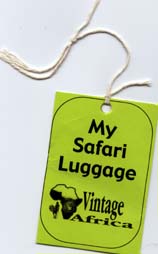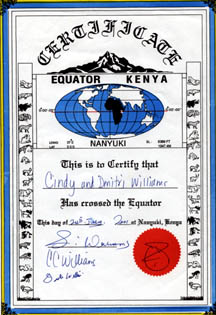
to Nairobi, Kenya
July 21
We woke up in Cambodia the morning of the 21st of July and we were definitely ready to leave. Couldn’t wait. We took an hour-long flight back to Bangkok and then had something like 12 hours before our next flight out. So we checked into the Amari airport hotel for a three hour “mini-stay.” We napped, cleaned up, got some dinner, and hung out and read until our 1 a.m. flight. We flew to Dubai and it was awful. It was a smoking flight which was disgusting, even though we were sitting in the non-smoking section. There were also many stinky people on the flight. We didn’t sleep much on the flight and when we got to Dubai, we crashed out on the airport floor until our flight to Nairobi.
The Dubai duty free area is HUGE!!! Checked for Horlick’s biscuits but couldn’t find them. Did find out that Dubai was voted the best airport shopping area in the world. We got into Nairobi early afternoon on Sunday the 22nd and went right to our hotel, Holiday Inn Mayfair Court. We were exhausted, spacy, basically zonked. We had dinner at Spurs restaurant in our hotel. We had been advised not to leave the hotel without our driver so we stayed in—too tired to do much of anything anyway. It was interesting to note that we had an armed guard on our floor in our hotel. Nice hotel, by the way. Typical Holiday Inn.
(Dmitri Says: Serious jet lag and two nasty long flights. And I gotta back Cindy up on here assesment of the other passengers: stinky.)
We had a three hour drive to the Mount Kenya area to our first stop, Mountain Lodge. We were greeted with hot towels and passion fruit juice. The air is much cooler in the mountains. It is a nice change from the heat of southeast Asia. There is a sign in the reception area—Do not feed the monkeys—and we are told to keep the windows closed so the monkeys don’t come in our rooms. We did keep the windows closed, but they managed to get them open. The monkeys came into our room and stole some biscuits. Cute, but bad monkeys! Called Sykes’ monkeys. All the rooms in Mountain Lodge overlook a water hole. We were only there a few minutes and Cape buffalo showed up. Very cool. The grass in the middle of the water hole is in the shape of Africa.


That afternoon, we went for hike with the hotel guide, David. We were accompanied by another guide with a machine gun. I stayed close to him, just in case we came across unfriendly animals. Just before we left for our hike, we were told that there were elephants at the water hole, so we all went back for a look. There were also Defassa water bucks there. David told us lots about the animals and also about Kenyan herbal medicine on our hike:
- Plant called a wait a bit—toddalia—for colds, flu, pneumonia
- The air in the mountains is clear, clean air—80% oxygen
- Watch out for safari ants—they bite, but can also be used for stitches
- Cocktail ants build nests in trees that look like birds’ nests
- Elephant dung burns slowly to keep your fire going, also is a good mosquito repellant—the smoke keeps the mosquitoes away
- We saw an aardvark hole
- Hyena makes a hole that has an outlet—a communal den with different rooms tunneled off with a little den 50 meters away so when the mom hyena gives birth the others don’t eat the baby
- There are 42 different tribes in Kenya and Kikuya is the biggest, with the most people, they live in the mountain area.
- They say if you see an aardvark (very rare since they are nocturnal) you will live 100 years
- In the forest there are rectangular holes made by Freedom Fighters, called Mau Mau (sp?) from 1952-1957, these holes are traps for water buffalo and also used to shoot enemies
- The strangler fig is a sacred, holy tree—it starts as a parasite and takes over the host tree with roots
- Ndai is their god, Ndai lives on Mount Kenya, the only place in Kenya there is snow—pristine; it is the highest mountain in Kenya
- Holy men decide which strangler figs are holy—then they kill a goat and spread the blood around the tree and roast half the meat (the smoke rises which is the way to talk to the god) and they put the other half of the meat on the tree; if it is still there the next day the god is angry and they have to do the whole process again
- The bark of the tree is good for treating diarrhea and cirrhosis of the liver
- The Kikuyu say that if you pee on the tree you will go mad
- The two biggest diseases in Kenya are AIDS and malaria
- Kenyans can’t afford to take the malaria pills every day like tourists do—it is too expensive so they have come up with herbal remedies for many ailments. They take devil’s horsewhip and this prevents malaria and treats it. It is given in tea two times a week and has low doses of quinine in it
- Kirinyaga is the Mt. Kenya in Kikuyu or Kiinyaa in Coomba—another tribe
It means place of the ostrich, when Germans came, they went home and misspelled it Kenya so tribes agreed to have one name - The first president of Kenya is Jomo (means very popular) Kenyatta (his nickname which means braided belt)

First Stop: Mountain Lodge
July 23rd.
One month of being married! We left the hotel early a.m. after being briefed on our trip. We spent an exorbitant amount of money to add on balloon rides and a visit to a Masai village. Our driver/guide is Fred. Our vehicle is a mini-bus that seats a group of 8. No other people have booked this trip so it is just us and Fred and we can spread out in the bus and have Fred to ourselves.




At this point we stopped our nature walk at a clearing where we sat on logs and had coffee or tea with little pieces of cake. We met a couple from Glendora who were alums from ‘SC. Small world.
On the way back to the lodge, we took a different route. The Kikuyu don’t retrace a route. They always take a different trail back just in case enemies were watching. We saw bucks running through the forest, but they were very far away. More info we learned on the way back:
Baboons put down leaves before they sit on the ground so no safari ants bite their soft bottoms—so we could see where baboons had been when we came across clusters of smushed down leaves.
Cape gooseberries, another herb, are good for women and treat bacterial infections of the eye
Mama elephants keep babies walking behind them to protect them—they keep track by flicking the tail back and forth
There are 42 different tribes and they have different languages but some common words
Mountain Lodge was built in 1971. It has a natural salt lick. It was started to protect the animals from poachers. When the lodge was built, they chased away poachers. The little round water hole is for elephants, but it has to be kept clean because they only drink clean water. Some animals that can be seen at the water hole: warthogs, bush pigs, giant forest hog (we saw some pig thing but are not sure which one), spotted hyena (we saw this at night, but not close up), leopard (did not see here), large spotted genet cat (we saw this in the middle of the night—it’s in the mongoose family but has the behavior of a cat), black rhino (did not see here), white-tailed mongoose (we saw it).
There are 2 types of rhinos-the black rhino and the white rhino. Both are grayish in color. They are different not in color, but in the shape of the mouth. Black rhinos were dying out (because of poachers) so white rhinos were brought from South Africa where there are lots of Dutch people who said they had “wide” mouths—so they became white rhinos. Rhinos have poor eyesight but a good sense of smell. So some poachers would get a rhino to run for them and then would stand behind a tree. The rhino would charge, get the horn stuck in the tree and the poacher would get the rhino.
At the lodge, there is a game spotter. At dinner, you tell him which animals you want to see and if they come to the water hole at night, he’ll come wake you up. We asked for both the leopard and the black rhino, but he didn’t come for us. There was a monkey on the balcony of the lodge who came and snatched a coffee cup and put his whole head in it. Then he took it and dropped it off the balcony. I can see how that kind of thing happens all the time with those Sykes’ monkeys.
We saw elephants from the low level hide. Very cool. Very close. Dmitri accidentally flashed one when trying to take a picture.
The food at the lodge is yummy and the hot chocolate is great. But we had to sit at a table by ourselves since they do seating by groups and we are the only two in our group. It is nice to have a driver and guide all to ourselves, but there were times we wished we had others so we could make friends, share stories and experiences, and hang out with other people.

 dmitri.usc@gmail.com
dmitri.usc@gmail.com